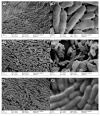Preparation, Characterization, and Mechanism of Antifreeze Peptides from Defatted Antarctic Krill (Euphausia superba) on Lactobacillus rhamnosus
- PMID: 35566118
- PMCID: PMC9104330
- DOI: 10.3390/molecules27092771
Preparation, Characterization, and Mechanism of Antifreeze Peptides from Defatted Antarctic Krill (Euphausia superba) on Lactobacillus rhamnosus
Abstract
Defatted Antarctic krill powder is the main by-product in the manufacturing of krill oil. Exploring a high value-added approach for utilizing this protein-rich material has received much attention in research and industry. Given this, the preparation and primary characterization of antifreeze peptides from defatted Antarctic krill (AKAPs) were carried out in this study. The cryoprotective effect of AKAPs on Lactobacillus rhamnosus ATCC7469 was also investigated. The results showed that Protamex was the optimum protease for AKAP preparation from defatted Antarctic krill. AKAPs were found to be rich in short peptides, with the MW ranging from 600 to 2000 Da (69.2%). An amino acid composition analysis showed that AKAPs were rich in glutamic acid (18.71%), aspartic acid (12.19%), leucine (7.87%), and lysine (7.61%). After freezing, the relative survival rate of Lactobacillus rhamnosus in the 1.0 mg/mL AKAP-treated group (96.83%) was significantly higher than in the saline group (24.12%) (p < 0.05). AKAPs also retarded the loss of acidifying activity of L. rhamnosus after freezing. AKAPs showed even better cryoprotective activity than three commercial cryoprotectants (sucrose, skim milk, and glycerol). In addition, AKAPs significantly alleviated the decrease in β-galactosidase and lactic dehydrogenase activities of L. rhamnosus (p < 0.05). Furthermore, AKAPs effectively protected the integrity of L. rhamnosus cell membranes from freezing damage and alleviated the leakage of intracellular substances. These findings demonstrate that AKAPs can be a potential cryoprotectant for preserving L. rhamnosus, providing a new way to use defatted Antarctic krill.
Keywords: Antarctic krill; Lactobacillus rhamnosus; antifreeze peptide; by-products; cryoprotectant; freezing.
Conflict of interest statement
The authors declare no conflict of interest.
Figures






Similar articles
-
Antifreeze Peptides Preparation from Tilapia Skin and Evaluation of Its Cryoprotective Effect on Lacticaseibacillus rhamnosus.Foods. 2022 Mar 17;11(6):857. doi: 10.3390/foods11060857. Foods. 2022. PMID: 35327279 Free PMC article.
-
Control on moisture distribution and protein changes of Antarctic krill meat by antifreeze protein during multiple freeze-thaw cycles.J Food Sci. 2022 Oct;87(10):4440-4452. doi: 10.1111/1750-3841.16308. Epub 2022 Sep 14. J Food Sci. 2022. PMID: 36102040
-
Improving the texture properties and protein thermal stability of Antarctic krill (Euphausia superba) by L-lysine marination.J Sci Food Agric. 2022 Jul;102(9):3916-3924. doi: 10.1002/jsfa.11741. Epub 2022 Jan 7. J Sci Food Agric. 2022. PMID: 34952978
-
[Behavioral and physiological ecology of Antarctic krill (Euphausia superba): A review].Ying Yong Sheng Tai Xue Bao. 2019 Dec;30(12):4344-4352. doi: 10.13287/j.1001-9332.201912.010. Ying Yong Sheng Tai Xue Bao. 2019. PMID: 31840481 Review. Chinese.
-
Reproductive traits of common Euphausids in the south of Antarctic Polar Front.Ying Yong Sheng Tai Xue Bao. 2021 Nov 15;32(11):4156-4164. doi: 10.13287/j.1001-9332.202111.029. Ying Yong Sheng Tai Xue Bao. 2021. PMID: 34898132 Review. English.
Cited by
-
Review on bioactive peptides from Antarctic krill: From preparation to structure-activity relationship and tech-functionality.Curr Res Food Sci. 2025 May 24;10:101093. doi: 10.1016/j.crfs.2025.101093. eCollection 2025. Curr Res Food Sci. 2025. PMID: 40520519 Free PMC article. Review.
-
Special Issue: Research and Application of Food By-Products.Molecules. 2023 Jun 5;28(11):4557. doi: 10.3390/molecules28114557. Molecules. 2023. PMID: 37299030 Free PMC article.
References
-
- Sands M., Nicol S., McMinn A. Fluoride in Antarctic Marine Crustaceans. Mar. Biol. 1998;132:591–598. doi: 10.1007/s002270050424. - DOI
-
- Yu F., Wang H., Jiang X., Lu T., Xue C. A New Multistage Counter Current Extraction Method of Removing Fluoride from Defatted Antarctic Krill Powder. J. Food Process. Preserv. 2020;44:e14437. doi: 10.1111/jfpp.14437. - DOI
MeSH terms
Substances
Grants and funding
LinkOut - more resources
Full Text Sources
Other Literature Sources
Molecular Biology Databases

